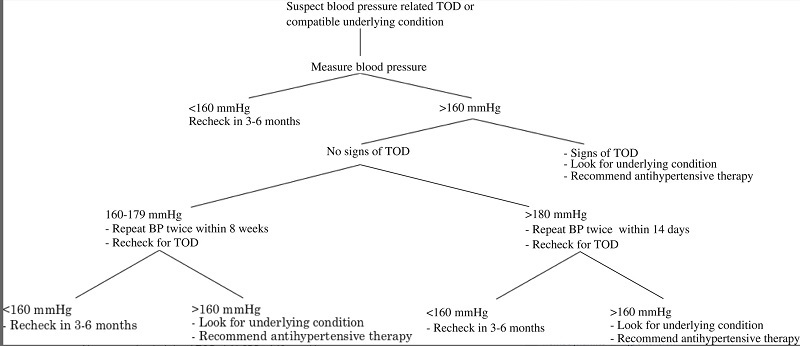S. Little
Causes
- Prevalence of hypertension increases with age in cats.
- Situational hypertension is common in cats as stress causes catecholamine release; however, the effects are variable and unpredictable.
- The two most common diseases associated with hypertension are chronic kidney disease (CKD) and hyperthyroidism. Hyperaldosteronism is less common but is an underappreciated cause. Hypertension in cats is not commonly associated with obesity, heart disease, or a high salt diet.
Clinical Signs
- Target organ damage (TOD): ocular, neurologic, cardiac
- Ocular signs include blindness, mydriasis, hyphema, retinopathy (edema, hemorrhage, detachment, vessel tortuosity). Important to do regular fundic examinations on senior cats.
- Neurologic signs are variable (ataxia, seizures, changes in mentation, head tilt, nystagmus), associated with acute increase in systolic blood pressure (SBP) or SBP>180 mm Hg.
- Cardiac effects include murmur, gallop rhythm, left ventricular hypertrophy. Changes are reversible and congestive heart failure is uncommon.
- Renal effects include azotemia, proteinuria, and progress CKD.
Measuring Blood Pressure
- Screening for hypertension should be performed for apparently healthy senior cats and cats with CKD, hyperthyroidism, and left ventricular hypertrophy. See Figure 1.
- Hypertension is classified based on the risk of TOD:
- Normotensive (minimal TOD risk) SBP <140 mm Hg
- Prehypertensive (low TOD risk) SBP 140159 mm Hg
- Hypertensive (moderate TOD risk) SBP 160–179 mm Hg
- Severely hypertensive (high TOD risk) SBP ≥180 mm Hg
BP should be measured with a standardized protocol to reduce external influences and produce reliable, reproducible measurements:
- Calm, quiet environment; allow time for acclimatization; use Feliway.
- Properly trained personnel
- Best equipment: doppler, high definition oscillometric
- Technique: discard first reading, get 5–7 readings with <20% variation, average the results
Use a standard form to record the protocol used and results
Figure 1. Approach to evaluation of potentially hypertensive patients

From ACVIM consensus statement: Guidelines for the identification, evaluation, and management of systemic hypertension in dogs and cats
Treatment of Hypertension
- Amlodipine: 0.125–0.25 mg/kg PO once daily (typically 0.625–1.25 mg/cat)
- Telmisartan (Semintra, 10 mg/mL)
- Europe: 2 mg/kg PO once daily; after 4 weeks, if SBP is <140 mm Hg, reduce dose by 0.5 mg/kg increments
- North America: 1.5 mg/kg PO every 12 hours for 14 days, then 2 mg/kg PO once daily; reduce dose by 0.5 mg/kg increments as needed
- Benazepril: not a first-line treatment, 0.5 mg/kg PO once daily
- Re-evaluate patients with serious TOD in 1–3 days; other patients in 1 week; ongoing re-evaluations at least every 4 months
References
1. ISFM Consensus Statement on the Diagnosis and Management of Hypertension in Cats
https://journals.sagepub.com/doi/pdf/10.1177/1098612X17693500
2. International Cat Care feline hypertension resources (forms, videos in various languages)
https://icatcare.org/vets/guidelines/hypertension-cats
3. ACVIM consensus statement: Guidelines for the identification, evaluation, and management of systemic hypertension in dogs and cats
https://onlinelibrary.wiley.com/doi/full/10.1111/JVIM.15331
4. International Cat Care YouTube channel with how-to videos
https://www.youtube.com/user/iCatCare/videos